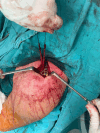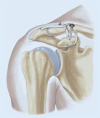Combined coracoclavicular ligament and transacromial capsule reconstruction for chronic acromioclavicular joint instability: clinical and radiological outcomes
- PMID: 40536360
- PMCID: PMC12147367
- DOI: 10.5152/j.aott.2025.25330
Combined coracoclavicular ligament and transacromial capsule reconstruction for chronic acromioclavicular joint instability: clinical and radiological outcomes
Abstract
Objective: Acromioclavicular (AC) joint instability remains a challenging clinical problem, particularly in chronic cases where both vertical and horizontal stability must be restored. Traditional techniques have limitations in addressing multidirectional instability and minimizing implant-related complications. The aim of this study was to evaluate the clinical and radiological outcomes of a combined coracoclavicular (CC) ligament and transacromial capsule reconstruction technique in patients with chronic AC joint instability. Methods: A retrospective study was performed on 40 patients who underwent AC joint reconstruction at a single center from 2019 to 2023. Radiological outcomes (clavicle-coracoid distance) were evaluated preoperatively, immediately postoperatively, and at the last follow-up (6 months). Functional results were assessed using the Constant, American Shoulder and Elbow Surgeons score (ASES), and Disabilities of the Arm, Shoulder, and Hand (DASH) score. Data were analyzed using SPSS v28.0. T-tests and repeated measures of Analysis of Variance (ANOVA) were employed to compare outcomes, with significance set at P < .05. Results: The preoperative mean CC distance was 20.3 ± 3.4 mm. Early postoperative measurements showed a significant reduction in CC distance, with a mean of 9.5 ± 1.5 mm in the capsule reconstruction group compared to 10.5 ± 1.6 mm in the non-reconstruction group (P=.053). At the 6-month follow-up, the late postoperative CC distance was maintained at 10.1 ± 1.6 mm in the reconstruction group, while it increased to 14.4 ± 2.0 mm in the non-reconstruction group (P < .001). The mean ASES score was 87.1 ± 8.1. The mean Constant score was 86.2 ± 7.6. Pain levels, evaluated using the Visual Analog Scale (VAS), decreased from a mean of 5.8 ± 1.2 preoperatively to 2.1 ± 1.0 postoperatively, indicating significant pain relief and improved functionality. No hardware failure or infection was noted. About 12.5% of patients experienced short-term anterior knee pain. Conclusion: The results of this study demonstrate that combined CC ligament and transacromial capsule reconstruction improves radiographic outcomes by maintaining the clavicle-coracoid distance and enhances functional scores (ASES and Constant) in patients with chronic AC joint instability. Addressing both vertical and horizontal instability appears to contribute to better short-term clinical recovery. Further studies with larger sample sizes and longer follow-up are needed to confirm these findings. Level of evidence: Level III (Retrospective Comparative Study).
Conflict of interest statement
Figures





Similar articles
-
Combined Superior Capsular Reconstruction Using Fascia Lata Autograft and Lower Trapezius Transfer Using Achilles Tendon Allograft Are Associated With Improved Surgical Outcomes in Patients With Chronic Posterosuperior Irreparable Massive Rotator Cuff Tears.Arthroscopy. 2025 Jul;41(7):2248-2258. doi: 10.1016/j.arthro.2024.11.096. Epub 2024 Dec 11. Arthroscopy. 2025. PMID: 39672244
-
[Suture anchor technique without knots for reconstruction of anterior talofibular ligament combined with reinforcement of inferior extensor retinaculum for treatment of chronic lateral ankle instability].Zhongguo Xiu Fu Chong Jian Wai Ke Za Zhi. 2025 Jul 15;39(7):837-842. doi: 10.7507/1002-1892.202504022. Zhongguo Xiu Fu Chong Jian Wai Ke Za Zhi. 2025. PMID: 40659586 Free PMC article. Chinese.
-
Acromioclavicular Fixation Before Coracoclavicular Tunnel Placement and Acromioclavicular Construct Design Improved Reduction and Stability in a Whole-Shoulder Girdle Model: A Pilot Study.Am J Sports Med. 2025 Jul;53(9):2041-2051. doi: 10.1177/03635465251349143. Epub 2025 Jun 26. Am J Sports Med. 2025. PMID: 40566939 Free PMC article.
-
Acromioclavicular reconstruction techniques after acromioclavicular joint injuries: A systematic review of biomechanical studies.Clin Biomech (Bristol). 2023 Jan;101:105847. doi: 10.1016/j.clinbiomech.2022.105847. Epub 2022 Dec 5. Clin Biomech (Bristol). 2023. PMID: 36521410
-
Clavicular tunnel widening after coracoclavicular stabilization surgery: a systematic review and meta-analysis.J Shoulder Elbow Surg. 2024 Mar;33(3):738-755. doi: 10.1016/j.jse.2023.09.037. Epub 2023 Nov 17. J Shoulder Elbow Surg. 2024. PMID: 37977250
References
-
- Eschler A Rösler K Rotter R Gradl G Mittlmeier T Gierer P. . Acromioclavicular joint dislocations: radiological correlation between Rockwood classification system and injury patterns in human cadaver species. Arch Orthop Trauma Surg. 2014;134(9):1193 1198. (doi: 10.1007/s00402-014-2045-1) - DOI - PubMed
MeSH terms
LinkOut - more resources
Full Text Sources
Medical
